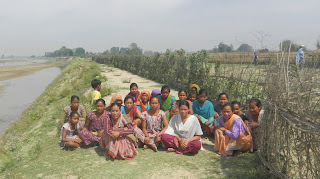In spring 2013, Ms. Katharina Schiller (MSc
student, University of Hohenheim) investigated the sustainability of leasehold
riverbed vegetable farming in the Terai of Nepal. She interviewed
landless and land-poor farmers in Kailali and Kanchanpur districts in
Far-Western Nepal. These farmers leased a minimum of 1354 m² (4 kattha, local
land area unit) of seasonally dry riverbed from the community or private land
owners to produce cucumbers, bottle and bitter gourds, pumpkins, and
watermelons for market sale.
 |
| Riverbed farming group in Hasuliya, Nepal |
Riverbed farming is an agricultural technology with
minimal negative environmental impact. It uses no energy besides human labor,
irrigation is necessary only if vegetables are grown on riverbanks, not in the
riverbeds, and it doesn't disturb the neighborhood with dust or noise. Since
the rivers change course often, requiring new beds to be dug, and farmers use
comparatively small amounts of chemical inputs. By covering the sandy
riverbeds, riverbed farming contributes to mitigating sandy dust in the air
(reduction of sand erosion). Also, the use of marginal land such as riverbeds
eases production pressure on arable land.
Also, riverbed farming has several positive
features. According to interviewed farmers, riverbed farming is an
easy-to-learn approach. Since it is based on lease of the riverbeds, it doesn't
have large start-up costs in terms of physical capital required. Different
types of spill-over effects were observed: The technology has been
independently replicated in several places by neighbors or in neighboring
villages. It was observed that not only the farmers themselves but also other
family members and neighbors gathered to listen during information sessions
with Local Resource Persons. Additionally, riverbed farmers are applying their
new skills, such as the use of compost or mulching, in their home gardens as
well.
All these criteria are taken into account for calculating a composite sustainability indicator of riverbed farming when comparing it with other technologies that the SATNET Asia project has collected with the help of its associates and network members.
All these criteria are taken into account for calculating a composite sustainability indicator of riverbed farming when comparing it with other technologies that the SATNET Asia project has collected with the help of its associates and network members.
Opportunities for the future support of riverbed farmers include facilitating a
stronger infrastructure so farmers enjoy easier access to markets for both
input buying and produce sales. A few groups traded surplus vegetables for
grains and goods within the village, but most farmers reported travel times of
1-2 hours by foot, bicycle or buffalo-drawn cart to the nearest market center
to buy seeds or sell their produce. Ensuring access to seeds early in the
growing season is crucial: an early planting enables an early harvest, which
fetches a much higher market price than during high season, when the
marketplace is glutted with vegetables both local and from neighboring India.
Another option to aid an early harvest is the construction of a group seedling
nursery in winter, so vegetables can be planted in early spring. Other
opportunities lie in the creation of savings or crop insurance cooperatives to
mitigate short-term environmental risk, introducing Integrated Pest Management
strategies to reduce use of pesticides and contribute to increasing
biodiversity, offering additional business training sessions to help farmers
diversify their income opportunities, creating stronger linkages to other local
projects (like community seed banks in neighboring areas), and more
farmer-to-farmer meetings for knowledge sharing.
BRAVO, Ms. Katharina Schiller! MARVELLOUS JOB!! STAY BLESSED!!!
ReplyDeleteWe congratulate from our hear to Ms. Katharina Schiller (MSc student, University of Hohenheim) for an excellent job done. We wish this message reaches and touches the hearts of the people in the developed world and one day we all unite to make the whole world.. A WONDERFUL PLACE!
ReplyDelete